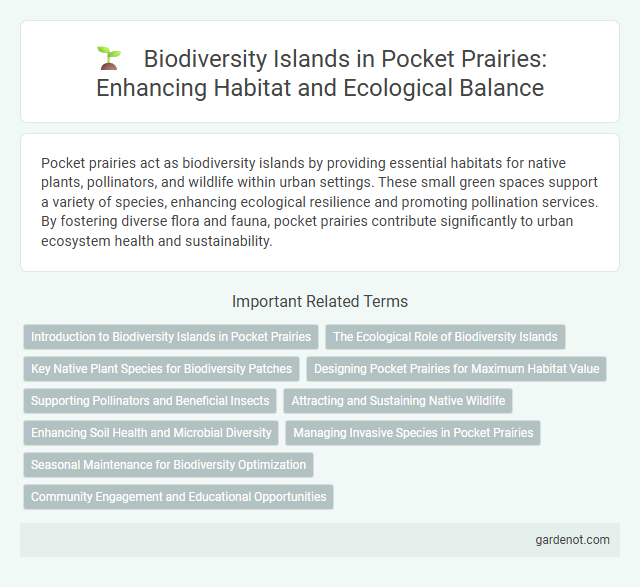Pocket prairies act as biodiversity islands by providing essential habitats for native plants, pollinators, and wildlife within urban settings. These small green spaces support a variety of species, enhancing ecological resilience and promoting pollination services. By fostering diverse flora and fauna, pocket prairies contribute significantly to urban ecosystem health and sustainability.
Introduction to Biodiversity Islands in Pocket Prairies
Biodiversity islands in pocket prairies serve as concentrated habitats that support diverse native plant and animal species, enhancing ecological resilience within urban landscapes. These small-scale prairies optimize habitat variety, enabling pollinators, birds, and beneficial insects to thrive amidst otherwise developed areas. By incorporating native grasses and wildflowers, biodiversity islands contribute to essential ecosystem functions such as soil stabilization, nutrient cycling, and habitat connectivity.
The Ecological Role of Biodiversity Islands
Biodiversity islands within pocket prairies serve as critical refuges for native flora and fauna, maintaining genetic diversity amidst urban landscapes. These islands facilitate pollination, pest control, and nutrient cycling, enhancing ecosystem resilience and productivity. By supporting diverse species interactions, biodiversity islands contribute to stabilizing microclimates and improving soil health in fragmented habitats.
Key Native Plant Species for Biodiversity Patches
Pocket prairies serve as vital biodiversity islands by incorporating key native plant species such as little bluestem (Schizachyrium scoparium), purple coneflower (Echinacea purpurea), and black-eyed Susan (Rudbeckia hirta), which provide essential habitat and food sources for pollinators and wildlife. These native grasses and wildflowers support soil health, enhance ecosystem resilience, and promote diverse insect populations critical for ecological balance. Strategic planting of these species in biodiversity patches helps restore native ecosystems and sustain local biodiversity.
Designing Pocket Prairies for Maximum Habitat Value
Designing pocket prairies for maximum habitat value involves selecting native plant species that support diverse pollinators, birds, and beneficial insects, creating a biodiversity island within urban landscapes. Incorporating a variety of flowering plants with staggered bloom times ensures continuous resources throughout the growing season, enhancing ecosystem resilience. Strategic placement of structural elements like logs and rocks further provides shelter and nesting sites, boosting the overall habitat quality and species richness.
Supporting Pollinators and Beneficial Insects
Pocket prairies serve as biodiversity islands by providing critical habitats and abundant floral resources that support pollinators such as bees, butterflies, and native insects essential for ecosystem health. These small-scale natural areas enhance pollination services, increase insect diversity, and contribute to the resilience of local food webs. By sustaining beneficial insect populations, pocket prairies promote natural pest control and improve the overall sustainability of urban and agricultural landscapes.
Attracting and Sustaining Native Wildlife
Pocket prairies serve as vital biodiversity islands by creating habitats that attract and sustain native wildlife such as pollinators, birds, and small mammals. Incorporating diverse native plant species provides essential food sources and shelter, promoting ecological balance and resilience. These green spaces enhance local biodiversity by supporting native species' life cycles and fostering connectivity within urban ecosystems.
Enhancing Soil Health and Microbial Diversity
Pocket prairies serve as biodiversity islands by significantly enhancing soil health and microbial diversity through diverse native plant roots that improve soil structure and nutrient cycling. These habitats support a wide range of beneficial microorganisms, including nitrogen-fixing bacteria and mycorrhizal fungi, which boost soil fertility and plant resilience. Increased microbial diversity in pocket prairies also promotes carbon sequestration and disease suppression, making them vital for sustainable ecosystem functioning.
Managing Invasive Species in Pocket Prairies
Managing invasive species in pocket prairies is crucial for maintaining native biodiversity and ecosystem stability. Effective strategies include regular monitoring, manual removal, and the use of targeted herbicides to control invasive plants such as reed canary grass and garlic mustard. Promoting diverse native plantings enhances resilience against invasions and supports a healthy habitat for pollinators and wildlife.
Seasonal Maintenance for Biodiversity Optimization
Seasonal maintenance in a pocket prairie enhances biodiversity by adapting care practices to specific plant life cycles and wildlife needs. Controlled burns, selective mowing, and invasive species removal during appropriate seasons promote native species growth and habitat diversity. Timing these interventions supports pollinators, ground-nesting birds, and beneficial insects, optimizing ecological balance and resilience.
Community Engagement and Educational Opportunities
Pocket prairies serve as biodiversity islands that foster community engagement by bringing local residents together to cultivate native plants and support pollinators. These small ecosystems provide hands-on educational opportunities, teaching participants about native species, habitat restoration, and environmental stewardship. Community workshops and school programs connected to pocket prairies enhance ecological literacy and promote sustainable urban gardening practices.
Biodiversity island Infographic

 gardenot.com
gardenot.com